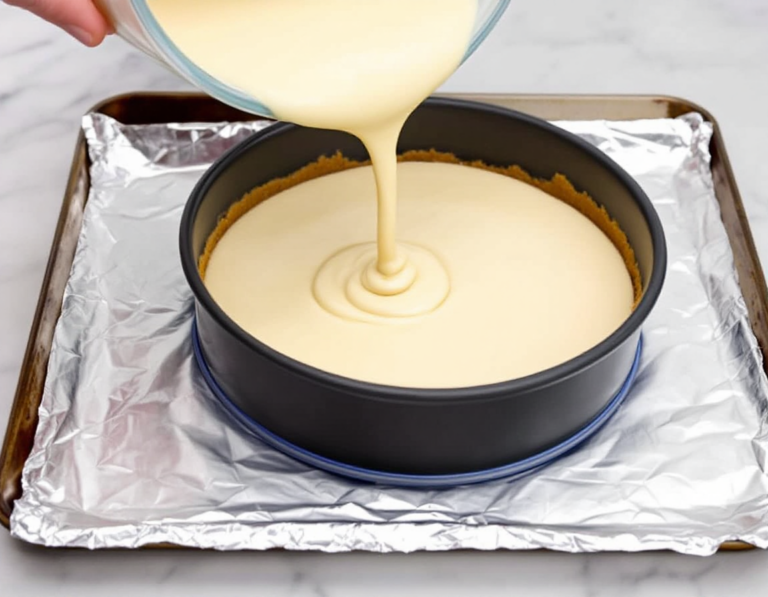
Ever had that moment when a dessert practically beckons you? That’s what this ultra-thick cheesecake does—it’s like a creamy, dreamy hug on a plate. Imagine sinking your fork into its luscious layers; it’s a bit like discovering your favorite song on an old vinyl, unexpected yet utterly indulgent.
Steps
- Preheat your oven to 325°F (160°C). In a bowl, combine graham cracker crumbs, sugar, and brown sugar. Stir in melted butter until well mixed.
- Press the crumb mixture into the bottom and up the sides of a 9-inch springform pan. Set it aside for later use.
- In a mixing bowl, beat the room-temperature cream cheese until smooth and creamy, being careful not to overbeat.
- Add sugar to the cream cheese and mix until creamy. Then, incorporate sour cream, vanilla extract, and salt, ensuring all ingredients are well blended.
- On low speed, gradually add the lightly beaten eggs, one by one, stirring just until each is incorporated. Scrape the sides and bottom of the bowl to ensure an even mix.
- Pour the cheesecake batter into the prepared springform pan. Place the pan on a foil-lined cookie sheet to catch any leaks.
- Bake on the center rack of your preheated oven for 50-60 minutes. The edges should be slightly puffed and lightly golden, while the center remains jiggly.
- Remove the cheesecake from the oven and let it cool on top for 10 minutes. Run a knife around the inside edge of the pan to loosen the crust, preventing cracks as it shrinks.
- Allow the cheesecake to cool at room temperature for 1-2 hours. Then, transfer it to the refrigerator to chill for at least 6 hours or overnight.
- Before serving, remove the springform pan’s ring. To store, place the ring back on and cover the top with foil. Enjoy your cheesecake!

Ingredients
- 1 ½ cups (170g) graham cracker crumbs
- 2 tablespoons sugar
- 1 tablespoon brown sugar (or substitute with white sugar)
- 7 tablespoons melted butter
- 32 oz (910g) cream cheese, softened to room temperature
- 1 cup (200g) sugar
- ? cup (160g) sour cream
- 1 ½ teaspoons vanilla extract
- ? teaspoon salt
- 4 large eggs, at room temperature and lightly beaten
Nutritional Values
Calories: 6000kcal | Carbohydrates: 384g | Protein: 96g | Fat: 432g | Saturated Fat: 264g | Polyunsaturated Fat: 12g | Monounsaturated Fat: 36g | Cholesterol: 2148mg | Sodium: 5400mg | Potassium: 540mg | Fiber: 12g | Sugar: 288g | Vitamin A: 14400IU | Calcium: 960mg | Iron: 10.8mg
FAQ
- Can I freeze cheesecake, and how do I do it?
- Yes, cheesecake can be frozen effectively. First, let it cool completely on the stovetop and in the refrigerator. Once chilled, wrap it securely in plastic wrap and then in foil. Cheesecake can be stored in the freezer for several months. To defrost, transfer it to the refrigerator and allow it to thaw overnight.
- Why is room temperature important for cheesecake ingredients?
- Using ingredients at room temperature ensures a smooth, lump-free cheesecake texture. This is particularly important for cream cheese, which should be soft to blend well with other ingredients.
- How can I avoid cracks in my cheesecake without using a water bath?
- To prevent cracks, avoid over-beating the eggs, don’t open the oven during baking, and allow the cheesecake to cool gradually at room temperature before refrigerating. Also, loosen the crust from the sides of the pan with a knife to prevent tension cracks as it cools.
- What should I do if my cheesecake isn’t setting properly?
- If your cheesecake isn’t setting, it may need more time in the oven. Bake until the edges have puffed slightly and the center has a slight jiggle but is set to the touch. The baking time can vary, so check every few minutes after the initial 50 minutes.
- How should cheesecake be stored?
- Cheesecake should be stored in the refrigerator, ideally with the springform pan ring replaced and the top covered with foil. It should not be left at room temperature for more than four hours to maintain its quality and safety.
Tips
- Use Room Temperature Ingredients: Ensure all your ingredients, especially cream cheese and eggs, are at room temperature before starting. This helps achieve a smooth, lump-free cheesecake texture.
- Handle Eggs Gently: Avoid over-beating the eggs to prevent cracks in your cheesecake. Lightly scramble each egg before adding it to your batter and mix on low speed until just combined.
- Avoid Opening the Oven Door: Resist the urge to open the oven door while the cheesecake is baking. Doing so can cause a drop in temperature, slowing the baking process and increasing the risk of the cheesecake sinking or cracking.
- Gradual Cooling: Allow your cheesecake to cool gradually at room temperature before refrigerating. This helps prevent cracks that could result from a sudden change in temperature.
Equipment
- Springform Pan – Essential for making cheesecakes as it allows for easy removal of the cake without damaging it.
- Stand Mixer or Hand Mixer – Useful for mixing the cream cheese and other ingredients to achieve a smooth and creamy consistency.
- Cookie Sheet – Used to place under the springform pan to catch any potential leaks.
- Spatula – Handy for scraping down the sides of the mixing bowl to ensure all ingredients are well-combined.